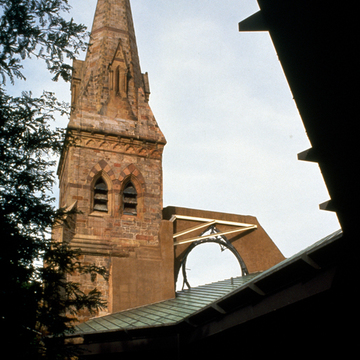Ware and Van Brunt won this commission through competition in 1865. Influenced by Ware's recent travels, the design reflects the work of “rogue” British church architects E. B. Keeling, Frederick Pilkington, and E. B. Lamb in the composition and placement of the tower, cloister, and entrance. Ware brought cartoons for the stained glass back with him from English artisans. First Church also shows the influence of John Ruskin in not only the use of Roxbury puddingstone, a highly textured conglomerate, but also the highly realistic carving of foliage for the cloister capitals. A fire in 1967 destroyed all but the tower, cloister, and rose window wall. Merging with Second Church at this time, the congregation commissioned Paul Rudolph, who successfully married the remaining elements of the original building with his lower vertically ribbed concrete structure and added a small external amphitheater and a preschool to the sanctuary. Particularly poignant is the view from Berkeley Street, where one can see both the rose window fragments and the newer structure.
Opposite the church, the French Library and Cultural Center, founded in 1945, occupies the former Edward Codman House (1867, 53 Marlborough Street), offering a lending library and an active program of lectures to promote cultural interchange between France and the United States.














